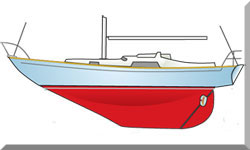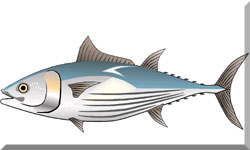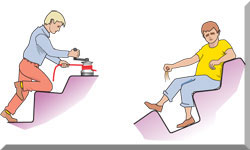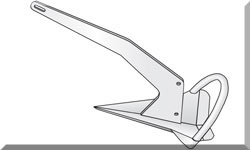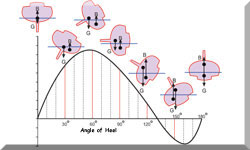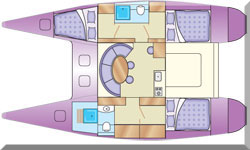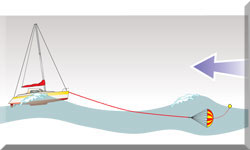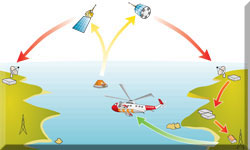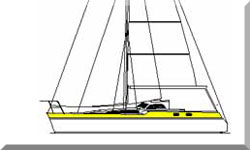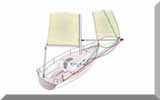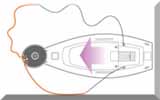- Home
- Reefing a Sail
- Single Line Reefing
Is Single Line Reefing
Right for Your Sailboat?
The single line reefing system is probably the easiest way to pull a reef in a mainsail and, providing the mainsail halyard and topping lift are led back to the cockpit, there's no need to clamber up to the mast to shorten sail.
Pulling In a Slab with a Single Line Reefing System
Single line reefing is a system designed to make reefing a mainsail more efficient and manageable, particularly for short-handed sailors. It allows both the luff (front) and leech (back) of the sail to be reefed using a single control line, reducing the number of steps required to shorten sail in strong winds.
How Single Line Reefing Works
- Setup: A single reefing line is routed through a series of blocks and pulleys, typically running from the cockpit or mast base, through the boom, and up to the reefing points on the sail.
- Activation: When the reefing line is pulled, it simultaneously lowers the sail at the luff and tightens the reefing point at the leech.
- Securing the Reef: Once the reef is pulled in, the halyard is re-tensioned, and the reefing line is secured, ensuring the sail is properly set for reduced wind exposure.
It doesn't get much simpler than the external system shown in the sketch below:
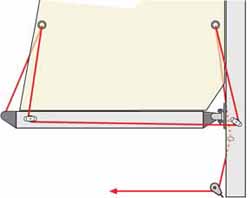 Single Line Reefing - a Simple, Seaworthy System
Single Line Reefing - a Simple, Seaworthy SystemStep-by-Step Reefing Process
- Ease the vang (kicking strap) and mainsheet to reduce tension.
- Head the boat into the wind to minimize sail pressure.
- Take up on the topping lift to support the boom.
- Release the halyard to lower the sail to the desired reef point.
- Pull in the reefing line, which tightens both the luff and leech reef points.
- Re-tension the halyard to secure the sail.
- Ease the topping lift to restore normal boom position.
- Adjust course and trim sails for optimal performance.
Internal (Inside the Boom) Systems
Some spar manufacturers incorporate single line systems inside the boom, which, although looking neater is:
- more expensive, and
- is difficult to repair when something breaks, and
- uses a two-part tackle which makes pulling a reef in easier, but
- the mechanical advantage works against you when letting a reef out.
There's only enough room inside the boom for the first two reef tackles, so the third reef - if there is one - has to be done with a standard slab reefing arrangement.
This means that in the very worst conditions you'll have to go to the mast anyway!
I know some offshore sailors that use this system have just two deep slabs in the mainsail, and rely on the trysail when things get really unpleasant.
On some boats the halyard is operated from the mast and the topping lift from the cockpit. In this arrangement it's best to keep the halyard and the reefing line in the same location, as you can deal with the topping lift before you leave the cockpit and when you return to it.
Clearly it makes a lot more sense to have everything all in the same place - either at the mast or in the cockpit - so you can deal with it on your own if you have to.
Single Line Reefing vs. Standard Slab Reefing
1. Single Line Reefing
Pros:
- Simplifies the reefing process by using one line to control both the luff and leech reef points.
- Allows reefing from the cockpit, improving safety in rough conditions.
- Reduces deck movement, making it ideal for solo sailors.
- Minimizes hardware complexity, compared to traditional slab reefing.
Cons:
- Increased friction due to multiple turns in the system, making reefing harder.
- Limited mechanical advantage, requiring more force to pull in the reef.
- Boom space constraints, as internal systems may only accommodate two reef points.
- Difficult to release a reef, as the mechanical advantage works against the sailor when shaking out a reef.
2. Standard Slab Reefing
Pros:
- More control over sail shape, as separate lines adjust the luff and leech independently.
- Less friction, making it easier to pull in and release reefs.
- More reliable in heavy weather, as it avoids the mechanical disadvantages of single line reefing.
- Can accommodate multiple reef points, including a third reef for extreme conditions.
Cons:
- Requires more steps, as separate lines must be adjusted.
- May require movement to the mast, increasing exposure in rough seas.
- More hardware complexity, with additional blocks and lines to manage.
Which System is Better?
- Single line reefing is best for short-handed sailors or those who prioritize cockpit safety.
- Standard slab reefing is preferred by offshore sailors who need greater control and reliability in extreme conditions.
Troubleshooting Tips for Common Reefing Issues
Reefing a sail efficiently can sometimes present challenges, especially in rough conditions. Here are some common problems and solutions:
1. Excessive Friction in the Reefing System
Problem: The reefing line is difficult to pull, requiring excessive force.
Solution:
- Use low-friction blocks and ensure all pulleys are properly lubricated.
- Check for twisted or tangled lines that may be increasing resistance.
- Consider upgrading to a thinner, high-strength rope to reduce friction.
2. Reefing Line Jams in the Boom or Blocks
Problem: The reefing line gets stuck, preventing smooth operation.
Solution:
- Inspect the internal boom system for obstructions or worn-out components.
- Ensure the reefing line is properly led through all designated blocks.
- Replace old or swollen rope that may be causing jams.
3. Difficulty Releasing a Reef
Problem: The sail does not easily shake out when the reefing line is eased.
Solution:
- Ease the halyard slightly before releasing the reefing line to reduce tension.
- Check for over-tightened reefing lines that may be restricting movement.
- Ensure the boom is properly supported to prevent excessive downward force.
4. Uneven Sail Shape After Reefing
Problem: The reefed sail appears baggy or poorly shaped.
Solution:
- Tension the halyard properly to maintain sail shape.
- Adjust the outhaul to flatten the reefed portion of the sail.
- Ensure the reefing points are evenly tensioned to prevent distortion.
5. Reefing System Fails in Heavy Weather
Problem: The reefing system does not function properly when conditions worsen.
Solution:
- Reef early before the wind increases to avoid struggling in rough seas.
- Consider installing a backup slab reefing system for extreme conditions.
- Keep a trysail ready for use if the mainsail becomes unmanageable.
Boat Size Limitations
You may be wondering if a single line reefing system for the mainsail of a 25 footer works just as well on a 45 footer.
The short answer is "No", and here's why:
The limitations of single line mainsail reefing systems...
Recent Articles
-
Sailing Sloop Rigs for Cruising: Are They the Best for You?
Aug 11, 25 04:25 AM
An experienced RYA Offshore Yachtmaster and YJA member breaks down the sailing sloop rig. Discover if a sloop is the ideal choice for your cruising ambitions by understanding the types, advantages, di… -
Trimarans vs. Catamarans: Weighing the Pros and Cons
Aug 10, 25 01:02 PM
Choosing between a trimaran & catamaran for your next cruising yacht? This guide, from an RYA Offshore Yachtmaster, breaks down the key differences in design, performance, and liveability to help you… -
The Ultimate Guide to Sailboats: Sloops, Ketches & More
Aug 10, 25 10:56 AM
A comprehensive guide to sailboat types. Learn the differences between monohulls and multihulls, sloops, cutters, ketches, yawls and schooners.


